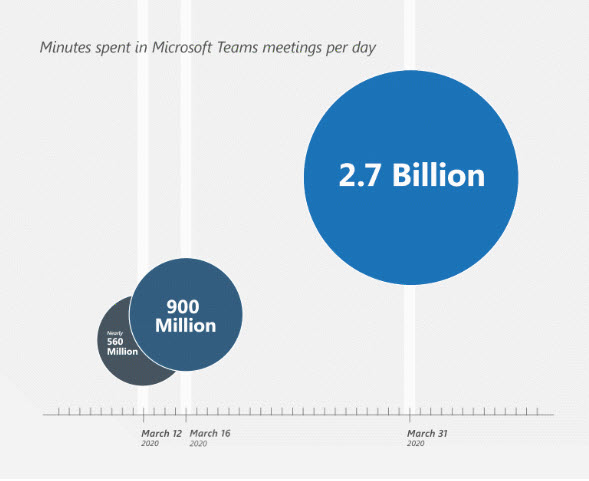With the huge increase in working from home (WFH) during the lockdown imposed by a number of countries during the COVID-19 pandemic, online meeting and video conference services have seen a huge increase in use. Microsoft Teams, Zoom, Cisco Webex, Google Hangouts and others have been widely adopted by companies that have been able to adopt a work from home strategy.
At the same time as businesses are adopting online meetings for WFH staff, clients and suppliers, schools, colleges and universities are adopting a similar policy for online learning.
 Because this has been a global phenomenon that has spread so quickly, there has been a huge spike in internet traffic.
Because this has been a global phenomenon that has spread so quickly, there has been a huge spike in internet traffic.
Zoom has acknowledged a large increase in usage of its platform and you only have to look at its share price to know that things are going pretty well right now – in spite of recent security concerns.
Microsoft has given a couple of indications of the growth of Teams in recent weeks – claiming 2.7 Billion minutes spent in Teams meetings on 31st March.
Office 365 admins will also be aware of the notifications that Microsoft has been putting out about some performance hits and restrictions to services.
This growth spurt is perhaps understandable given the speed of the rise in usage but perhaps surprising as ‘scalability’ is a key selling point for all the main cloud services players – Microsoft Azure, Amazon Web Services and Google Cloud Services.
Perhaps ‘cloud’ resources aren’t as scalable as we are being told. After all, there has to be a data centre somewhere providing the computing power to run all these ‘cloud’ services. And there has to be bandwidth to deliver them.
With spike from WFH coupled with a huge portion of the education sector moving to online learning, the current infrastructure might not be good enough. Add in the demands of IoT devices, gaming and streaming audio and video services and maybe we won’t be able to meet the demands of business and consumers if these lockdowns continue.
If there aren’t enough data centres – or even enough power to run them – what happens next? Throttling? Rationing? More expensive connections to guarantee performance.
Could the system break? Short of long term issues with power to data centres, probably not. But what if demand exceeds the existing capacity and we can’t build data centres fast enough to keep up?
Your fast fibre internet connection isn’t worth much if Microsoft or Google can’t keep their Office 365 and G Suite services running.
The next few weeks will be an interesting test of just how scalable cloud computing really is!
Need Help?
Trade IT is all about using technology to improve your business processes. This might mean new kit, the latest app or software package – but more often than not it is about organising your business processes to
If you have Office 365 or G-Suite or Zoho One, you probably aren’t taking full advantage of the capabilities you are already paying for. The technology available to even the smallest organisations today is incredible – but few companies (whatever their size) are taking full advantage.
If you need help, get in touch. Fill in the form below or just email help@tradeit.uk.com



Recent Comments